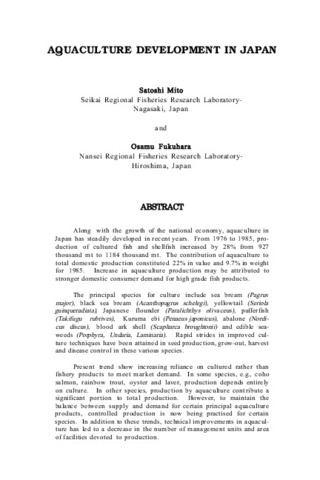Aquaculture-based restoration and stock enhancement of tiger shrimps in the Philippines
- Global styles
- MLA
- Vancouver
- Elsevier - Harvard
- APA
- Help

View/
Date
2016Page views
4,781ASFA keyword
environmental degradation 
stocking density
resource management
survival
catch/effort
brackishwater aquaculture
growth
socioeconomic aspects
brackishwater environment
fishing grounds
feeding
stocking (organisms)
feeds
shrimp culture
aquaculture regulations
resource conservation
estuaries
carrying capacity
stock assessment
environmental impact
livelihoods
shrimp fisheries
cage culture
culture effects
stocks

stocking density

resource management

survival

catch/effort

brackishwater aquaculture

growth

socioeconomic aspects

brackishwater environment

fishing grounds

feeding

stocking (organisms)

feeds

shrimp culture

aquaculture regulations

resource conservation

estuaries

carrying capacity

stock assessment

environmental impact

livelihoods

shrimp fisheries

cage culture

culture effects

stocks

AGROVOC keyword
Taxonomic term
Metadata
Show full item record
Share
Abstract
In central Philippines, the Aquaculture Department of the Southeast Asian Fisheries Development Center (SEAFDEC/AQD), with strong collaboration and support from the Research Institute for Humanity and Nature (RIHN) of Kyoto, Japan, has been looking into the stock enhancement of tiger shrimp Penaeus monodon in the New Washington Estuary (NWE), province of Aklan, central Philippines. The NWE was a productive fishing ground that has been suffering from degenerating brackishwater fisheries and estuarine environment. Average daily catch declined from 24 kg in 1970s to only 0.7 kg at present. Shrimp fisheries, the most important livelihood, declined in quality and quantity. Tiger shrimps were abundant in catch until the early 1990s when these were observed to decline in volume, replaced by smaller and cheaper species. This was coincidental with the rapid decline in mangrove cover for ponds and huge increase in fishing pressure. It is clear that crucial interventions are required to restore the tiger shrimp fisheries in the NWE in order to increase income of local fishers, while promoting reduction of fishing gears and restoration of mangroves. Stock enhancement of tiger shrimps shows good potential in answering these needs. Site-specific assessments were conducted to evaluate prospects of shrimp stock enhancement in NWE. Conservative simulations of capture of released stocks showed that fishers can increase income by 300%. To decrease fishing pressure in the area, number of gears per fisher may have to be reduced but shrimp catches will be relatively high-priced. Comparative experiments using aquaculture techniques were done to identify strategies especially in the delicate intermediate acclimation rearing. Aquaculture protocols like those for pond preparation were also adapted to be used in a mangrove pen nursery rearing system for shrimps. Supplemental feeding with formulated feeds increased carrying capacity of the culture area, while enhancing growth and survival of stocks. Culture experiments showed that shrimps grow to 0.5 g within 1 mo and >1g in 2 mo. High stocking density of 40-60 shrimps m-2 can be used for <2 mo rearing in a mangrove pen. Release experiments showed that 60-d old shrimps have higher chances of survival when released in the estuaries. With strong support from local communities, government and other sectors, together with effective management and law enforcement, aquaculture-based stock enhancement of tiger shrimps can be a viable intervention to restore livelihood and promote estuarine rehabilitation in the NWE.
Suggested Citation
Altamirano, J. P., Salayo, N., Kurokura, H., Fushimi, H., & Ishikawa, S. (2016). Aquaculture-based restoration and stock enhancement of tiger shrimps in the Philippines. In K. Hajime, T. Iwata, Y. Theparoonrat, N. Manajit, & V. T. Sulit (Eds.), Consolidating the Strategies for Fishery Resources Enhancement in Southeast Asia. Proceedings of the Symposium on Strategy for Fisheries Resources Enhancement in the Southeast Asian Region, Pattaya, Thailand, 27-30 July 2015 (pp. 166-170). Samutprakan, Thailand: Training Department, Southeast Asian Fisheries Development Center.
Type
Conference paperCollections
- Conference Proceedings [299]
Related items
Showing items related by title, author, creator and subject.
-
The Philippine aquaculture industry
Camacho, Arsenio S.; Macalincag-Lagua, Natividad (Aquaculture Department, Southeast Asian Fisheries Development Center, 1988)The aquaculture sector of the Philippine fishing industry registered the highest growth rate of 12.5% in 1977-1986. The contribution of aquaculture to the total fish production was equivalent to 24% in 1986 compared to ... -
Aquaculture development in Japan
Mito, Satoshi. (Aquaculture Department, Southeast Asian Fisheries Development Center, 1988)Along with the growth of the national economy, aquaculture in Japan has steadily developed in recent years. From 1976 to 1985, production of cultured fish and shellfish increased by 28% from 927 thousand mt to 1184 thousand ... -
Nursery and grow-out operation and management of Penaeus monodon (Fabricius)
Corre, Kaylin G. (Aquaculture Department, Southeast Asian Fisheries Development Center, 1988)The results of research on nursery and grow-out rearing of prawn conducted by the SEAFDEC Aquaculture Department for over a decade are reviewed. Different rearing facilities designed to accommodate hatchery-produced prawn ...





